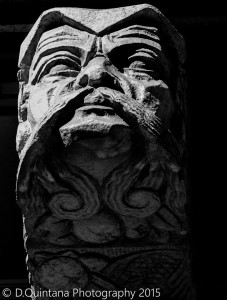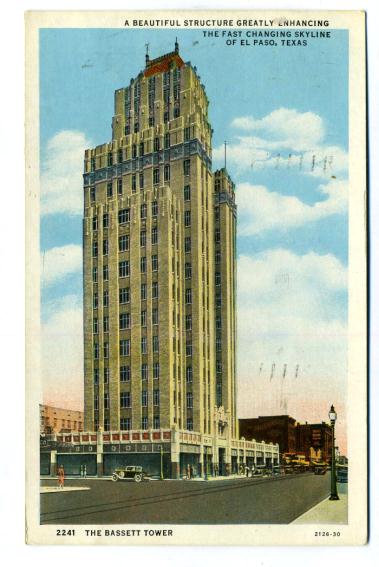
Relief. O.T. Bassett Tower, 1930. Art Deco.
In the late 19th century, highly influential individuals walked the streets of El Paso and saw what many of us see today – potential. Oscar Thomas Bassett was no different. When he arrived in the Borderland via stagecoach across the Butterfield Overland Trail in 1880, he took full advantage of the opportunities our city had to offer. As the owner of the Texas and Pacific Railway, Mr. Bassett initially traveled to the region to purchase real estate. Over the next two decades, he helped found the First National Bank of El Paso and several other prominent institutions in the city.
After Oscar’s death in 1898, his son Charles N. Bassett moved to El Paso to handle the business his father left behind. He found his time in the burgeoning city to be equally lucrative. With his wealth, as well as a desire to continue growing the legacy his father established, Charles Bassett set out to build a structure in his honor. His vision was to construct the tallest building in West Texas, and Bassett enlisted the talent of Trost & Trost to design the massive structure. The project was completed in less than a year after breaking ground. Considering O.T. Bassett Tower stands at 198 feet tall and was designed to house 200 offices and eight stores such a feat is quite remarkable. At the time of completion, it was the most expensive building in El Paso, the overall cost was $500,000, or about $7,000,000 today.
Those numbers speak for themselves. All of that space was intended to be occupied by the city’s prominent businessmen and fellow entrepreneurs. Basset had made an investment in a town which had reciprocated the gesture. He had set out to create something magnificent in a place that had treated his family quite well, and the monument to this mutual success still stands today. Modern El Pasoans walk by this structure regularly, perhaps contemplating what stories transpired within the limestone and concrete walls.
The W.S. Hills building, also located downtown, is another ornate structure built in honor of one of our city’s great citizens. Hills arrived in El Paso by the same means that Basset did, a dangerous two-week journey by stagecoach. Upon stepping foot on the town’s dirt roads, he too was greeted by the same muse. Hills managed the Campbell Real Estate Company and found his way here on an expedition to investigate the firm’s holdings in the area. He realized that the company owned roughly three-quarters of the town, and in anticipating the subsequent establishment of railroads in the area jumped at the chance to capitalize on the coming economic tide.
Hills realized that rapid construction would follow the arrival of the railroad. To take advantage of what was sure to come, he opened a brick manufacturing company to provide contractors with the materials necessary to follow suit. His vision made him a millionaire, and he became a prominent member of elite society in the state. He went on to further shape downtown El Paso by erecting several other structures in the area and named Lee and Florence Street after his son and daughter.
After his death, his wife hired Trost & Trost to build a structure in place of their home. The building has two matching façades which face East San Antonio and Texas Avenue. They are constructed with a hybrid concrete material that is intended to resemble marble. Upon close inspection, while walking by the building one can see small hearts engraved around it’s entrances at eye level. They act almost as a seal to this beautiful love letter of sorts for her late husband.
Famous El Paso artist Tom Lea rented a studio on the second floor during the thirties in which he commissioned “Pass to the North.” Today, the current owners are restoring the structure to lease to new tenants, ushering 21st-century business and life into a building that stands as a monument to thus. In the case of the Basset Tower, Lane Gaddy, who purchased the building in 2014 is currently repurposing the skyscraper to become a hundred room Starwood Aloft Hotel. Anyone who has visited these locations in other cities can attest to their allure, and El Paso should be excited.
These modern El Pasoans looked at these fantastic structures and saw the same potential that inspired those whom they are named after. They seek to usher in a new age of economic and cultural development in our city, and given the current shift in social climate, they will undoubtedly be rewarded. Sometimes we need to look at our past to be inspired to forge a bright new future. Hopefully, like in the case of the stories mentioned above, other visionaries will take heed.
– Christopher M. Gonzalez, 2016
– Research courtesy of Dr. Max Grossman


